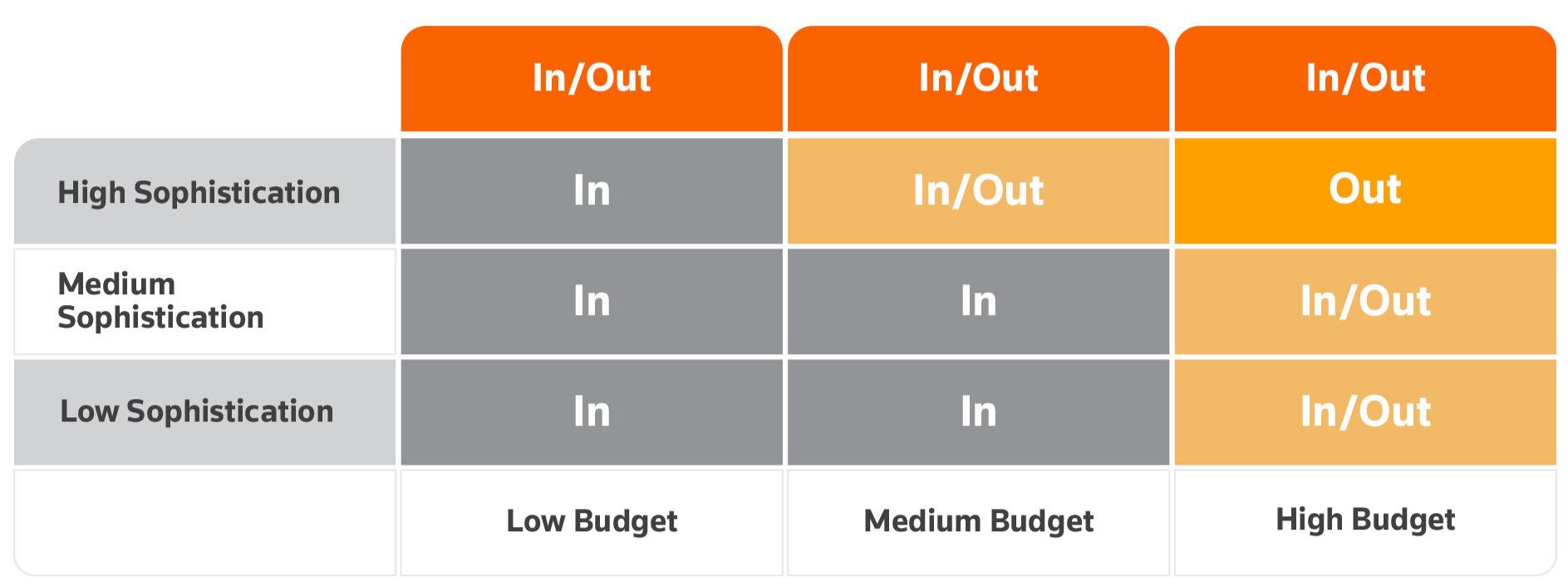In-house counsel are constantly evaluating when to send work to outside counsel and when to keep it (or bring it back in). It is a surprisingly difficult task. Not only are in-house departments keeping work, but they are more frequently taking it back from their outside lawyers. Below I discuss some of the factors you should consider when deciding when to send work to outside counsel and when to keep it.
Do you have a choice?
Figuring out when to send work out or when to keep it starts with a fundamental question – do you have a choice? There are many legal departments, especially small ones, that have no budget for outside legal advice. This means they never send work to outside counsel and simply make do on their own. Still, the first time the company finds itself as a defendant in a major lawsuit this position will have to change. Assuming you can engage outside counsel, the single largest factor becomes money, as in “Can we afford outside counsel for this project?” Many legal departments have generous budgets with money specifically set aside for outside counsel to handle different types of legal work. Others have a small amount of budget that must last for the entire year and they allocate it on an as-needed basis as issues arise. While better than having no budget, it puts pressure on the general counsel to determine what matters are “worthy” of outside counsel spend and which are not.
Do you have the people?
Perhaps you are fortunate and money is not an issue. Even so, you still need to decide what to send out. The “what” in large part depends on the people you have on your team. You must understand what the members of your team are capable of (or what you want them to learn). Regardless, there will likely be legal issues that no one has the right background to handle. For example, most in-house legal departments are not equipped to handle large litigation internally. That type of work must go to outside counsel. The solution is to create a skills chart to ensure that you know what your team cannot and cannot handle. This will allow you to look internally with more confidence before sending something outside.
What does the math tell you to do?
Of course, there is math involved, for example, what does it cost you to send the work outside vs. handle it internally? Here are two things to measure:
- What is your overall outside counsel spend and how much could you save by bringing the work back inside or by bringing on someone new to handle the work that is going outside?
- Calculate the lost opportunity/lost deals cost of not sending work out. For example, it is common for most companies to have surges in commercial agreements at the end of each quarter. If you do not have enough hands to do all the work internally, how many contracts don’t get done and what is the value of those “lost” contracts? Compare the value to the business of getting those contracts done with the cost of sending them to outside counsel (or hiring a new lawyer).
 | White paper With the right tools, legal teams can practice at the top of their license. |
Do you have the right outside counsel?
Another important factor is whether or not you have the right outside counsel lined up. Am I going to pay $600 an hour for help with contracts when I can find the same quality lawyer who will do it for $350 or even a flat fee? Do I have outside counsel that has made the effort to understand my business so that their legal advice is more tailored and not so generic? Is my outside counsel willing to partner with me? Have I considered alternative legal service providers? In short, before I send anything outside, have I analyzed the lay of the land and have a good sense of all my options, and am confident that I am sending the right work to the right firm at the right price point?
Can technology help?
More and more, access to technology drives decisions on what work goes outside and what stays. For example, if I have access to a state-of-the-art contract assembly tool, I am far less likely to need to send contracts outside. Such a system will also permit my team to focus on higher-value contracts or, potentially, shift their focus onto other legal work as the demand for their time to work on contracts is lessened. This other legal work is work that would have potentially gone outside or simply not gotten done. You don’t need sophisticated technology to enhance productivity; standard templates, checklists, and collaboration tools can dramatically increase the amount of time in-house lawyers have available to spend on different types of work.
Are you burying your team?
I think all in-house lawyers understand that there will be times when weekends and evenings are needed to work on important projects. But if it becomes most weekends and most evenings you will burn out your team and quality will sag, or worse, people will start to quit. The pain of replacing someone who is a regrettable departure dwarfs the pennies you are saving by not finding ways to manage or reduce the workload, either by sending work to outside counsel or simply saying “no” to the business. When things are running too hot you need to find a way to cool things off.
Do you have a process to help you decide?
There is nothing wrong with deciding where to send legal work on an ad hoc basis. My preference, however, is to have a process in place to help me decide. It can be a checklist, a flowchart, or decision matrix, or whatever. But having a systematic way of looking at a matter to help decide quickly (and correctly) whether it belongs inside or outside is a smart move. I have used a 3×3 matrix to help decide. The X axis (bottom left to right) tells me how much money I have available to spend on outside counsel (running from low to high). The Y axis (left side bottom to top) tells me how sophisticated the work is (running from simple to highly sophisticated). When I have a high budget and need high sophistication, I send the work “out.” When I have low budget and low sophistication, I will keep it inside (“in”). There are some places in the 3×3 where I can go either way, i.e., keep it or send it out depending on the circumstances (“in/out”). Here’s what it looks like:

The important thing is to have some type of orderly process to help you make decisions about where work goes. Still, these tools are guidelines, not laws carved on stone tablets. As with most things, your judgment and common sense will lead you to the right answer no matter what it says on the chart.
_______________________________________________________________________
One of the most important tasks faced by in-house lawyers is deciding what work will be done in-house and what gets sent outside. The key is having a process to help you think through all the issues before deciding. If you have access to Practical Law, you have thousands of tools to help you keep work within the department or do a better job managing what you do send outside.
_______________________________________________________________________
STERLING MILLER, HILGERS GRABEN PLLC
Sterling Miller is currently CEO and Senior Counsel at Hilgers Graben PLLC. He is a three-time General Counsel who spent almost 25 years in-house. He is the author of five books and writes the award-winning legal blog, Ten Things You Need to Know as In-House Counsel. Sterling is a regular contributor to Thomson Reuters as well as a sought-after speaker. He regularly consults with legal departments and coaches in-house lawyers. Sterling received his J.D., with honors, from Washington University in St. Louis.











